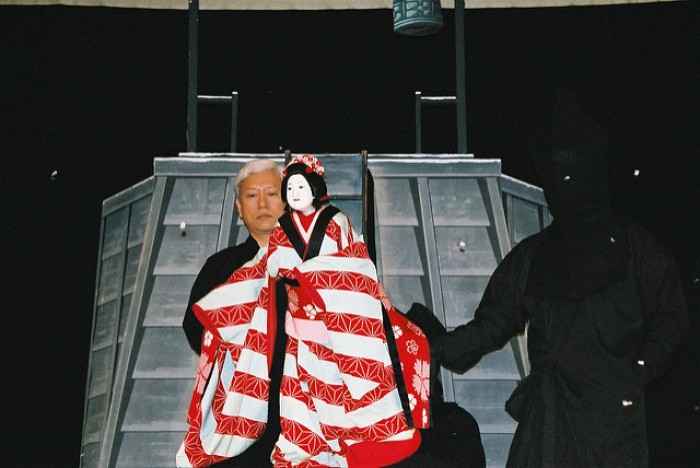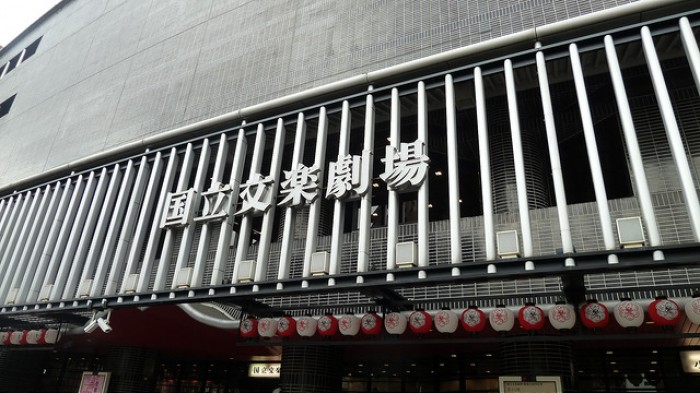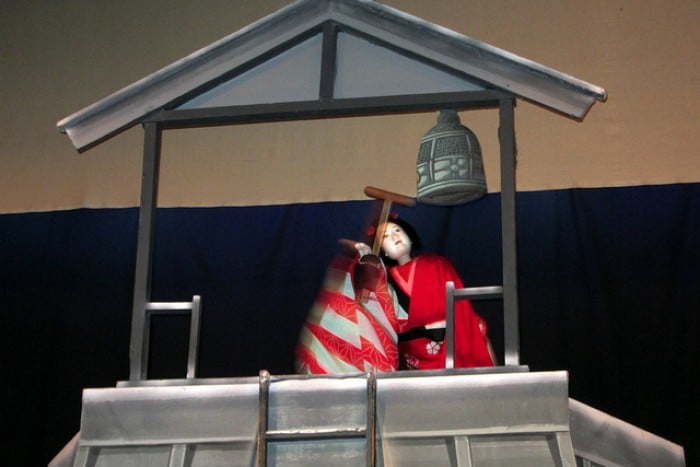When I told my Japanese friend that I wanted to see a Bunraku performance, she initially thought I was mixing up some vocabulary. No one she knew ever wanted to see Bunraku show – she even admitted that she hadn’t seen one herself.
Most foreigners will wonder what Bunraku is and why one should go. My short answer is Takeshi Kitanto. Growing up in Germany, the ridiculously funny slapstick TV show Takeshi’s Castle was my very first introduction to what became later one of Japan’s most celebrated contemporary filmmakers. My eventual admiration for his films (many years after I watched Takeshi’s Castle) has led me to the film Dolls (2002).
If you know anything about his films, you know that yakuza (a powerful Japanese criminal organisation), violence and sly humour characterise them. However, Dolls is one of the films that stood out over the rest. What had left a lasting impression on me, besides beautiful shots and a highly stylised setting, were the actual doll performances: Bunraku.
Bunraku is a traditional form of Japanese puppetry which has its origins in the 17th century. Most people shy away when they hear puppetry, thinking that this form of entertainment is for children of the age of six and below. However, Bunraku is more sophisticated, spectacular and multi-layered than anything I have seen before – and this is coming from someone who hated puppetry while he was growing up.
 Image credit: Kate Nevens
Image credit: Kate Nevens
More modern forms of entertainment have pushed Bunraku performances into the background. However, if you long to explore and investigate the deeply rooted grace, precision and artistry of the Japanese, Bunraku performances will give you access to a hidden side of modern-day Japan.
Please don’t expect a few puppets on strings, flying somewhat awkwardly over the stage. One puppet, or doll, is navigated by at least three people, making the performance of the doll quite humanlike. In general, a traditional performance consists of the puppeteers, the chanters and the shamisen musicians. While the latter two are usually composed of only two people, the number of puppeteers can reach up to 40 people, depending on the number of dolls on the stage.
Where to go?
 Image credit: Sophia Lucero | National Bunraku Theatre, Osaka
Image credit: Sophia Lucero | National Bunraku Theatre, Osaka
Bunraku originates from Osaka, which is, until today, still the centre of this particular performance culture. The National Bunraku Theatre in Osaka and the National Theatre in Tokyo are the best places to see it. Although a group of performers occasionally – meaning once every couple of years – travels abroad, the chances of you catching it in your city is rather small. The tickets are rather inexpensive for what you are offered, considering that you will easily spend more money on a night out in Tokyo.
As I couldn’t find anyone who wanted to join me, I went by myself to see a show in Osaka. In case you are afraid of the language barrier – you don’t have to be. The theatre in Osaka even provided me with a small guidebook in English, explaining the setup of the stage, amongst other things, and a headset that translated everything that was spoken on stage. Score!
The performance
 Image credit: Wally Gobetz
Image credit: Wally Gobetz
To my surprise, the theatre was almost filled, even though the performance was set in the early afternoon. I have to say, though, that I was perhaps the youngest in the audience and definitely the only foreigner. However, I was welcomed with the typical Japanese politeness. I even had the impression that many people were happy about my attendance.
The performance itself was more spectacular than I had expected and truly entertaining all throughout the two-hour show. All starts with the chanter and the musician appearing next to the stage. While the musician plays the three-stringed shamisen, the chanter expresses the emotions and personalities of the dolls, mimicking voices, accents and cries of all characters on stage.
You might think that this could get exhausting to watch, but it’s actually quite the contrary. The longer the performance lasted, the more I was drawn in by the impressions of the chanter, voicing flawlessly the desperate cries of a woman while switching within a second to the deep and roaring outbursts of a male character. Everything is, of course, highly choreographed, stylised and coordinated with the performers on stage.
I honestly often caught myself forgetting about the presence of actual people on the stage. Being intensely emerged into the story about 19th century Japan, one wonders what the fascination really is.
Why should you go?
While it isn’t a secret that the Japanese culture is extremely rich, deep and hard to immediately access and understand for foreigners, Bunraku offers a look back to the roots of Japanese sophistication. A society that is so full of contradictions today definitely has balance, emotion and drama at its core.
Walking around Osaka’s streets after the performance, I saw Bunraku everywhere I looked. It isn’t hard to imagine that, besides all of the modernity, everything begins with the drama and the conflicts one witnesses at a Buraku performance.





